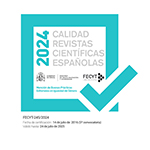Diagnosis of didactic deficiencies and difficulties of oral communication in the Spanish classrooms
Abstract
The need to train in oral communication is justified in the pre-university curriculum and in all didactic studies on orality. However, the reality of teaching the oral language in Spanish as a mother tongue is deficient, since written discourse prevails in linguistic communication training and it has not been known to incorporate into the teaching practice the pragmatic analysis that has contributed so much to the theory of oral communication. The objective of this paper is to present the didactic deficiencies and difficulties that sustain this situation in order to promote a prospective initial training in the bachelor’s degree in primary education that integrates the study of oral discourse in educommunicative approaches. The methodology that research the diagnosis of these deficiencies and difficulties is based on several instruments: 1) a survey of 298 students of Education from four universities to find out their formative awareness; 2) the analysis of twenty textbooks from different educational stages to know the space and the approach dedicated to oral discourse; and 3) a contrastive study with four European countries with a wide tradition in teaching the oral language to assess differences with training in Spain. The results of these analysis show specific didactic difficulties focused on an inadequate methodology for the evaluation in oral communication. Changes in initial teacher training are required to develop teaching models from pragmatic theory.
Downloads
Article download
License
In order to support the global exchange of knowledge, the journal Didáctica. Lengua y Literatura is allowing unrestricted access to its content as from its publication in this electronic edition, and as such it is an open-access journal. The originals published in this journal are the property of the Complutense University of Madrid and any reproduction thereof in full or in part must cite the source. All content is distributed under a Creative Commons Attribution 4.0 use and distribution licence (CC BY 4.0). This circumstance must be expressly stated in these terms where necessary. You can view the summary and the complete legal text of the licence.










